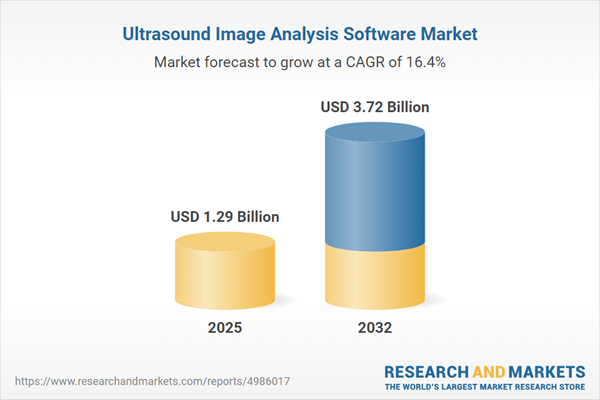Speak directly to the analyst to clarify any post sales queries you may have.
Ultrasound image analysis software now plays a central role in healthcare by supporting clinical accuracy and operational improvements. Senior leaders in healthcare organizations are increasingly prioritizing advanced software solutions to align with evolving regulatory standards and achieve strategic goals for digital transformation.
Market Snapshot: Ultrasound Image Analysis Software Market
The global ultrasound image analysis software market is experiencing robust growth, valued at USD 1.10 billion in 2024 and projected to expand to USD 1.29 billion by 2025 and further reach USD 3.72 billion in 2032, driven by a notable compound annual growth rate of 16.40%.
This momentum is shaped by swift advances in artificial intelligence integration, rising demand for faster diagnostic results, and increasing investment in digital health platforms. Additionally, evolving regulatory priorities and a focus on international standards are prompting organizations to favor software that enhances interoperability and compliance. The market’s evolution draws leadership attention to technology adoption as a means of differentiating strategy and performance within the broader healthcare technology ecosystem.Scope & Segmentation of the Ultrasound Image Analysis Software Market
Understanding the comprehensive segmentation of the ultrasound image analysis software market empowers decision-makers to align investments with organizational strategies and regional objectives. Current segmentation reflects a need for adaptability in deployment models, specialty requirements, and responses to shifting global conditions.
- Modality: 2D and 3D/4D imaging solutions address a spectrum of clinical scenarios, supporting collaboration between departments and enhancing the resolution of diagnostic information.
- Deployment: Cloud, on-premises, and hybrid platforms enable organizations to adjust data management and security based on operational or compliance priorities.
- Application: The technology services diverse specialties such as cardiovascular care, radiology, musculoskeletal analysis, obstetrics and gynecology, oncology, and urology, integrating smoothly within established care pathways to improve diagnostic accuracy.
- End User: Hospitals, clinics, ambulatory surgery centers, and diagnostic laboratories leverage these applications to strengthen interdepartmental workflow and standardize data use across locations.
- Regional Markets: Adoption is shaped by variations in regulations, reimbursement systems, and healthcare infrastructure across the Americas, Europe, Middle East & Africa, and Asia-Pacific. Regional specificity in vendor offerings and compliance design underpins software selection and implementation.
- Key Companies: Notable players—General Electric Company, Siemens Healthineers AG, Koninklijke Philips N.V., Canon Medical Systems Corporation, Fujifilm Holdings Corporation, Samsung Medison Co., Ltd., Mindray Medical International Limited, Hologic, Inc., Esaote SpA, and Butterfly Network, Inc.—drive product innovation and influence technological standards globally.
Key Takeaways for Senior Decision-Makers
- Standardized workflows through ultrasound image analysis software foster consistent access to specialist expertise, ensuring operational alignment across multiple facilities and care networks.
- AI-powered analysis tools help to establish uniform diagnostic protocols, minimizing clinical interpretation gaps and reinforcing confidence in decision-making teams.
- Flexible software deployment—including cloud and hybrid formats—enables organizations to synchronize technology investments with compliance requirements and variable infrastructure resources.
- Modular system designs ease the process of adapting to emerging regulations or clinical methodologies, supporting staggered rollouts and integration with legacy systems as organizational needs evolve.
- Collaborative relationships with equipment manufacturers and research entities support interoperability improvements, enhancing operational continuity in networked or multisite organizations.
- Emphasis on regulatory alignment reduces risk and supports technology decisions aimed at long-term strategic and clinical outcomes.
Tariff Impact and Supply Chain Adaptation
Recent adjustments in U.S. tariffs have prompted healthcare executives to re-evaluate procurement and sourcing processes for ultrasound image analysis solutions. By cultivating supplier diversity and considering domestic alternatives, organizations can increase supply chain resilience and limit exposure to external trade disruptions. Open-source and modular strategies also offer added flexibility for managing costs and responding swiftly to changing policy requirements in real time.
Methodology & Data Sources
This report synthesizes insights from structured interviews with healthcare IT leaders and clinical managers, supported by detailed analysis of secondary research tracking industry trends and changing regulations. The combination delivers a nuanced understanding of technology adoption and market shifts.
Why This Report Matters for Senior Leadership
- Enables effective planning for digital initiatives by presenting actionable trends in ultrasound image analysis software deployment.
- Supports comparison of leading vendors and clarifies regional variations, facilitating well-informed decisions on technology partnerships and software adoption.
- Provides practical guidance for optimizing sourcing, enhancing supply chain strategies, and integrating digital health platforms amid regulatory changes.
Conclusion
Ultrasound image analysis software offers a strategic avenue for organizations aiming to elevate clinical precision and operational efficiency. This report equips senior decision-makers with the insights necessary to guide technology adoption and foster sustainable growth in a competitive healthcare environment.
Additional Product Information:
- Purchase of this report includes 1 year online access with quarterly updates.
- This report can be updated on request. Please contact our Customer Experience team using the Ask a Question widget on our website.
Table of Contents
3. Executive Summary
4. Market Overview
7. Cumulative Impact of Artificial Intelligence 2025
Companies Mentioned
The companies profiled in this Ultrasound Image Analysis Software market report include:- General Electric Company
- Siemens Healthineers AG
- Koninklijke Philips N.V.
- Canon Medical Systems Corporation
- Fujifilm Holdings Corporation
- Samsung Medison Co., Ltd.
- Mindray Medical International Limited
- Hologic, Inc.
- Esaote SpA
- Butterfly Network, Inc.
Table Information
| Report Attribute | Details |
|---|---|
| No. of Pages | 194 |
| Published | October 2025 |
| Forecast Period | 2025 - 2032 |
| Estimated Market Value ( USD | $ 1.29 Billion |
| Forecasted Market Value ( USD | $ 3.72 Billion |
| Compound Annual Growth Rate | 16.4% |
| Regions Covered | Global |
| No. of Companies Mentioned | 11 |









